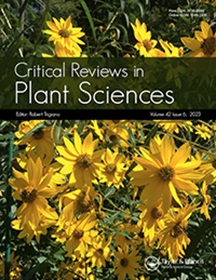Rumble in the Effector Jungle: Candidate Effector Proteins in Interactions of Plants with Powdery Mildew and Rust Fungi
IF 4.9
2区 生物学
Q1 PLANT SCIENCES
引用次数: 15
Abstract
Abstract Rust and powdery mildew fungi are widespread obligate biotrophic phytopathogens. They colonize a broad range monocotyledonous and dicotyledonous host plant species and in the case of crop plants can cause severe yield losses. While powdery mildews (Ascomycota) grow mainly epiphytically and infect the host epidermis, rust fungi (Basidiomycota) typically enter host tissues through stomata and spread within the intercellular spaces. Both fungal taxa have unusually large genomes that are rich in repetitive elements (mostly derived from retrotransposons) and experienced a convergent loss of genes usually present in free-living fungi compared to their respective relatives. Genomes of rust and powdery mildew fungi encode many candidates for secreted effector proteins thought to aid the suppression of defense and cell death or to mediate nutrient acquisition. Although the precise biochemical activity of most effector proteins remains obscure, candidate host targets have been identified for several of them. In addition, some effectors are perceived by matching plant immune receptors and thus serve as avirulence determinants in plant-fungus interactions. This review article summarizes the current knowledge of rust and powdery mildew effector proteins and raises and discusses urgent questions regarding future research. Abbreviations: AVR: avirulence protein; BiFC: bimolecular fluorescence complementation; CSEP: candidate secreted effector protein; ETI: effector-triggered immunity; f. sp.: forma specialis; ff. spp.: formae speciales; MS: mass spectrometry; RIP: repeat-induced point mutation; R protein: resistance protein; sRNA: small RNA; TE: transposable element; Y2H: yeast-2-hybrid.效应丛林中的隆隆声:植物与白粉病和铁锈真菌相互作用中的候选效应蛋白
摘要锈菌和白粉菌是分布广泛的专性生物营养性植物病原体。它们在广泛的单子叶和双子叶寄主植物物种中定居,在作物植物的情况下可造成严重的产量损失。白粉病(子囊菌科)主要生长在附生并感染宿主表皮,而锈真菌(担子菌科)通常通过气孔进入宿主组织并在细胞间隙内传播。这两种真菌类群都有异常大的基因组,富含重复元素(主要来自反转录转座子),并且与它们各自的亲缘真菌相比,它们经历了通常存在于自由生活真菌中的基因的趋同丢失。锈病和白粉病真菌的基因组编码了许多候选的分泌效应蛋白,这些蛋白被认为有助于抑制防御和细胞死亡或介导营养获取。虽然大多数效应蛋白的确切生化活性尚不清楚,但其中一些候选宿主靶标已被确定。此外,一些效应器被匹配的植物免疫受体感知,因此在植物-真菌相互作用中作为无毒决定因素。本文综述了目前对锈病和白粉病效应蛋白的研究进展,并对今后研究中亟待解决的问题进行了讨论。AVR:无毒蛋白;BiFC:双分子荧光互补;CSEP:候选分泌效应蛋白;效应触发免疫;F. sp.:特殊形式;ff。特殊形式;MS:质谱法;RIP:重复诱导点突变;R蛋白:抗性蛋白;sRNA:小RNA;TE:转座元素;Y2H: yeast-2-hybrid。
本文章由计算机程序翻译,如有差异,请以英文原文为准。
求助全文
约1分钟内获得全文
求助全文
来源期刊
CiteScore
12.90
自引率
1.40%
发文量
15
审稿时长
>12 weeks
期刊介绍:
Critical Reviews in Plant Sciences focuses on presenting in-depth and up-to-date reviews of timely and/or cutting-edge subjects in the broad discipline of plant science, ranging from molecular biology/biochemistry through the areas of cell biology, plant pathology and physiology, genetics, classical botany, and ecology, to practical agricultural applications. Articles in the journal provide an up-to-date literature base for researchers and students, pointing the way towards future research needs. The journal is also a significant source of credible, objective information to aid decision makers at all levels.

 求助内容:
求助内容: 应助结果提醒方式:
应助结果提醒方式:


